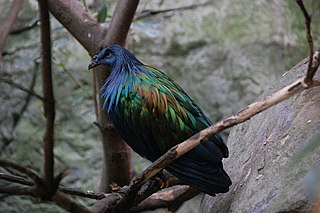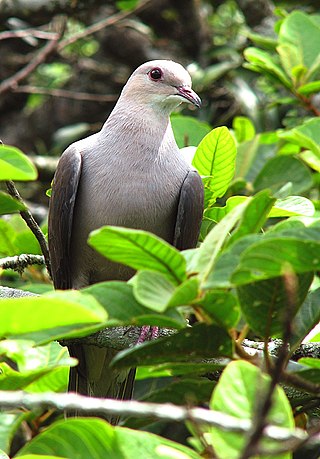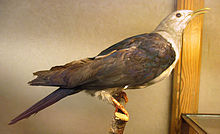
The Nicobar pigeon or Nicobar dove is a bird found on small islands and in coastal regions from the Andaman and Nicobar Islands, India, east through the Indonesian Archipelago, to the Solomons and Palau. It is the only living member of the genus Caloenas alongside the extinct spotted green pigeon and Kanaka pigeon, and is the closest living relative of the extinct dodo and Rodrigues solitaire.

Caloenas is a genus of pigeons. The only living species is the Nicobar pigeon.

The green imperial pigeon is a large forest pigeon. The large range extends from Nepal, southern India and Sri Lanka eastwards to southern China, Indonesia and the Philippines.

The emerald dove or common emerald dove, also called Asian emerald dove and grey-capped emerald dove, is a widespread resident breeding pigeon native to the tropical and subtropical parts of the Indian Subcontinent and Southeast Asia. The dove is also known by the names of green dove and green-winged pigeon. The common emerald dove is the state bird of the Indian state of Tamil Nadu. The Pacific emerald dove and Stephan's emerald dove were both considered conspecific.

The pied imperial pigeon is a relatively large, pied species of pigeon. It is found in forest, woodland, mangrove, plantations and scrub in Southeast Asia, ranging from Myanmar and Thailand, throughout Indonesia and east to the Philippines and the Bird's Head Peninsula in New Guinea. It is mainly found on small islands and in coastal regions. It remains locally common, and is therefore considered to be of least concern by BirdLife International and IUCN.

Ducula is a genus of the pigeon family Columbidae, collectively known as imperial pigeons. They are large to very large pigeons with a heavy build and medium to long tails. They are arboreal, feed mainly on fruit and are closely related to the other genus of fruit-eating doves, Ptilinopus. Both genera display brightly coloured plumage, predominantly green, often with contrasting under-parts of purple, orange or red. Some Ducula have prominently swollen ceres. They have large gapes and swallow seeds whole, playing an important role in seed dispersal.

The cinnamon-bellied imperial pigeon or cinnamon imperial pigeon is a species of bird in the family Columbidae. It is endemic to the northern Moluccas. Its natural habitat is subtropical or tropical moist lowland forests.
The spotted imperial pigeon, also known as the grey-necked imperial pigeon, is a species of bird in the family Columbidae. Endemic to the Philippines, it lives in forests and forest edges but goes down to the limestone shorelines possibly to feed. It is a vulnerable species threatened by habitat loss and hunting.
The Rufescent Imperial Pigeon, also known as the Shining Imperial Pigeon, is a rare species in the world of birds. According to The International Union for Conservative, this species is relatively unknown, and their concern is very minimal. The Union describes that this species is very stable and does not encounter threats from other species The trait of stability is vital in differentiating The Rufescent Imperial Pigeon from the other species confronting threats. This bird in specific does not frequently encounter threats because they are more reserved, quiet birds that tend to remain alone in their habitat. The habitat of these birds allows them to have the frequency of being independent but also gives them the chance to be with other birds. Rooting from the bird family in Columbidae, that also consists of pigeons and doves. In which this family is known for being frugivorous, meaning it primarily feeds on fruit, figs, and seeds.

The white-bellied imperial pigeon is a species of bird in the pigeon family Columbidae. First described by the French ornithologist Charles Lucien Bonaparte in 1854, it is endemic to Indonesia, where it is found on Sulawesi, Buton, Taliabu, Togian, and Peleng. It inhabits primary forest, dense secondary forest, and isolated areas of hill forest. A large pigeon with a long tail, it measures 42.5–51.5 cm (16.7–20.3 in) long and weighs 510 g (18 oz) on average. Males are mainly green, with pale-grey heads and bellies, chestnut vents, and a pale grey tail band, along with a red orbital ring. Females are nearly identical, but have darker grey areas in their plumage.

The black imperial pigeon, also known as the Bismarck imperial pigeon, is a species of bird in the pigeon family, Columbidae. First described by English zoologist Philip Sclater in 1878, it is endemic to the Bismarck Archipelago, where it mainly inhabits rainforest and cloud forest in mountain areas above 500 m (1,600 ft). It is a large, heavily built imperial pigeon, with a length of 38–43 cm (15–17 in) and a weight of 661–665 g (23.3–23.5 oz). Adults are almost entirely black, except for the dark chestnut undertail coverts, the silvery-grey underside of the tail, and a pale grey scaly pattern on the wings and back. Both sexes look alike. Juveniles differ from adults in having paler undertail coverts.
The spice imperial pigeon is a species of bird in the family Columbidae. It is endemic to Indonesia, where it occurs in the eastern Moluccas and the Raja Ampat Islands. Its natural habitats are subtropical or tropical moist lowland forests and subtropical or tropical mangrove forests. It eats, and is an important disperser of seeds for, fleshy fruits.

The Micronesian imperial pigeon, also known as the Micronesian pigeon, and Belochel is a species of bird in the family Columbidae (doves). It is found in Palau, the Caroline Islands, the Marshall Islands and Nauru. Its habitats include montane forests, secondary forests, forests on beaches, and mangroves. It is threatened by hunting and deforestation, and the IUCN has assessed it as a near-threatened species.

The Pacific imperial pigeon, Pacific pigeon, Pacific fruit pigeon or lupe is a widespread pigeon species in the family Columbidae. It is found in American Samoa, the Cook Islands, the smaller islands of eastern Fiji, Kiribati, Niue, the smaller satellite islands of Papua New Guinea, Samoa, Solomon Islands, Tokelau, Tonga, Tuvalu, Vanuatu, and Wallis and Futuna Islands.

The spectacled imperial pigeon is a species of bird in the family Columbidae. It is endemic to the Maluku Islands.

The grey imperial pigeon is a species of bird in the family Columbidae. It is found in the Sulu Archipelago, Miangas and Talaud Islands. It is a small island specialist where its natural habitats are tropical moist lowland forests and plantations. It is threatened by habitat loss.

Pinon's imperial pigeon or Pinon imperial pigeon is a species of bird in the family Columbidae. It is found in New Guinea. The species is named after Rose de Freycinet née Pinon. Several subspecies have been designated:

The island imperial pigeon or floury imperial pigeon is a species of bird in the family Columbidae. It is found in the Bismarck Archipelago and the Solomon Islands archipelago, living in primary and secondary forests and mangroves. The International Union for Conservation of Nature (IUCN) has assessed it as a least-concern species.

The spotted green pigeon or Liverpool pigeon is a species of pigeon which is most likely extinct. It was first mentioned and described in 1783 by John Latham, who had seen two specimens of unknown provenance and a drawing depicting the bird. The taxonomic relationships of the bird were long obscure, and early writers suggested many different possibilities, though the idea that it was related to the Nicobar pigeon prevailed, and it was therefore placed in the same genus, Caloenas. Today, the species is only known from a specimen kept in World Museum, Liverpool. Overlooked for much of the 20th century, it was recognised as a valid extinct species by the IUCN Red List only in 2008. It may have been native to an island somewhere in the South Pacific Ocean or the Indian Ocean, and it has been suggested that a bird referred to as titi by Tahitian islanders was this bird. In 2014, a genetic study confirmed it as a distinct species related to the Nicobar pigeon, and showed that the two were the closest relatives of the extinct dodo and Rodrigues solitaire.

The Malabar imperial pigeon or Nilgiri imperial pigeon is a species of bird in the family Columbidae. It is endemic to the Western Ghats of India.


















